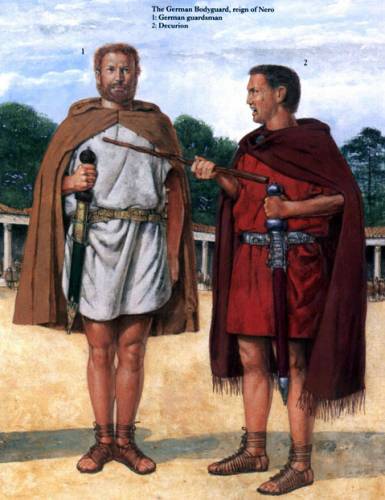Reconstruction of a guardsmen of the Germani Corporis Custodes in palace duty dress. These were picked men who formed a personal bodyguard for the emperors from the time of Augustus until about 70 A.D., and again from the early 3rd century onwards. They were often used to counter the ambitions of the Praetorian Guard.
Augustus recruited his mounted bodyguard mainly from the Batavians, because of their equestrian abilities. Later the guard was called Germani or corporis custodes. It lasted throughout the Julio-Claudian period; then with the death of Nero and the end of the dynasty it was dissolved (R. Paribeni, “Dei Germani corporis custodes,” RM 20 (1905), p 321-329).
An important characteristic of the corps was its private, unofficial character. That is, in organization and status the corps was part of the monarch’s household rather than a component of the Empire’s military establishment. This was in line with the distinction maintained under the Principate between servants of the emperor and officials of the state. Tiberius stressed this before the Senate on one recorded occasion: “The soldiers (i.e., milites) do not belong to me but to the state.” (Dio Cassius, 57.8)
At first, indeed, the custodes were servants in the fullest sense, for the original members of the corps seem to have been all slaves. Later some custodes received the status of freedmen, others were enrolled as free peregrines; but at no time could the custodes be called milites, i.e., soldiers of the state. They remained a private, dependent body, and as such had a separate and inferior status. Roman writers carefully distinguish between milites and custodes: e.g. excubias militares… et Germanos; pedites equitesque permixti Germanis; abducta militum et Germanorum statione. (Tacitus, Annals 13.18; 15.58; Seutonius, Nero 34) In each of these, it will be noted, we see detachments from the two corps used together; no doubt each had its particular function just as during the Republic. The praetorians mounted guard outside the imperial palace or tent, serving as an excubiae, while the custodes served as bodyguards.
Another significant difference is in the chain of command. The praetorians were under the orders of the praetorian praefectus, chief of staff to the emperor and generally a senior army officer. The custodes, on the other hand, were commanded by one of the emperor’s servants, always either a slave or freedman. Thus Caligula chose as captain of the guard his chamberlain Helicon, a slave whose other duites included playing ball and practicing gymnastics with the Emperor. (Philo, Legatio ad Gaium 175) At the time of Caligula’s assassination his captain of the guard was Sabinus, a former gladiator (Josephus, Ant. Jud. 19). Claudius made his freedman Narcissus captain, and actually raised him to the rank of general by bestowing on him the officer’s sword (pugio); Nero honored similarly his freedman Tigellinus. (Tacitus, Ann. 11.33; Philostratus, vita Apoll. 4.42)
It is worth noting briefly at this point the outstanding characteristics of the corps of Batavians, for it established precedents which were long followed. First, the corps was recruited from barbarian tribes on the Empire’s borders, its members were without citizenship, and it was officered by slaves and freedmen, the lowest social classes. This was quite contrary to all Roman military traditions and set the corps apart from the armed forces of the state, including the praetorian cohorts. This was done as a matter of policy. The emperors trusted the Batavians, says Tacitus, “because they were foreign.” (Tacitus, Ann. 15.58)
Second, the corps’ duties were entirely limited to protection of the emperor and his family. The Batavians did not, for example, play any part in official ceremonies, as did the praetorians. (e.g., the formal reception and military review held by Nero in honor of King Tiridates, as described by Suetonius, Nero 13)
Finally, members of the corps could not transfer to other troop units, and they never entered the officer corps. This is implicit in the points noted above, but deserves to be stressed here for the sake of contrast with practices of the Later Empire.
R.I. Frank, Scholae Palatinae: The Palace Guards of the Later Roman Empire, Papers & Monographs of the American Academy in Rome Vol. 23. (Irvine, CA: American Academy in Rome, 1969), 24-26.
